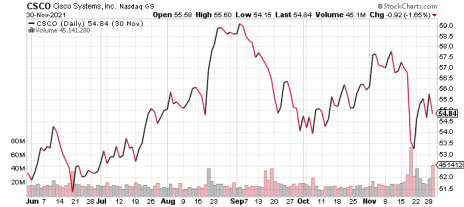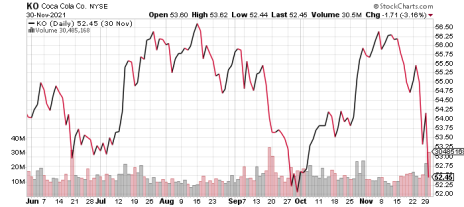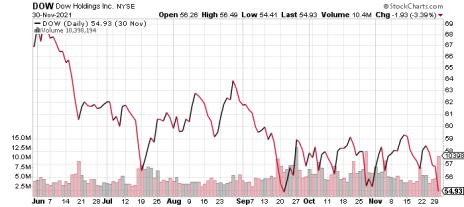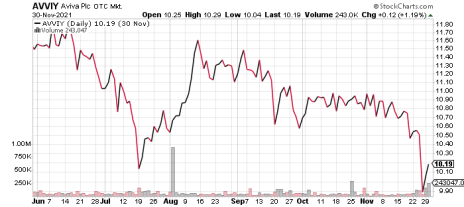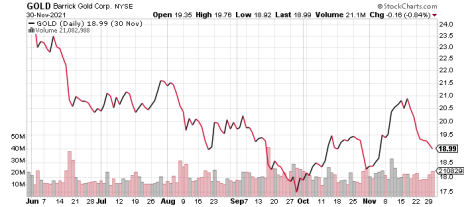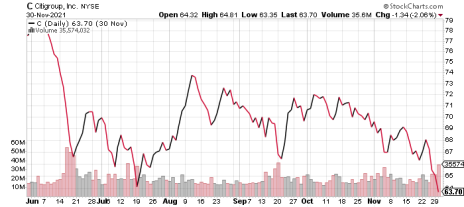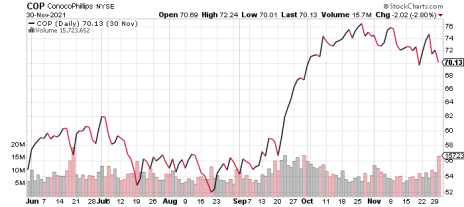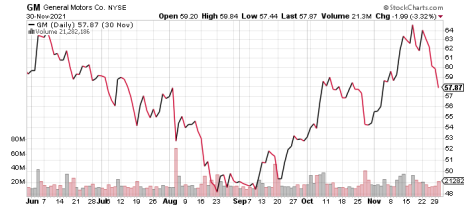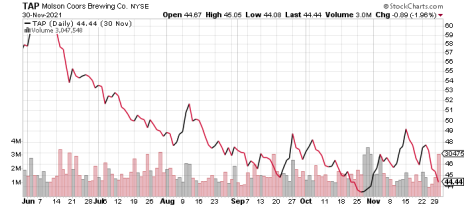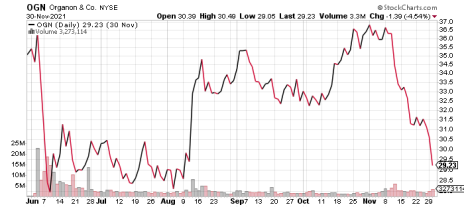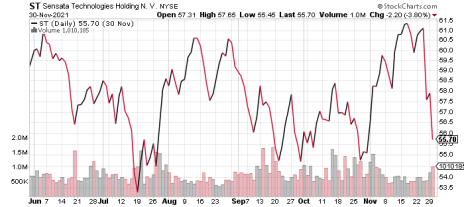Thank you for subscribing to the Cabot Undervalued Stocks Advisor. We hope you enjoy reading the December 2021 issue.
The emergence of the Covid Omicron variant has temporarily upended the market’s emerging post-Covid view of the economy. We share our thoughts on this, as well as on Fed Chair Powell’s testimony this week about accelerating the bond-buying taper. We also comment on how artificial selling pressure as the calendar year-end approaches can drive already-weak stocks to steeply undervalued levels.
Market Overview
Omicron, Powell and Year-End Selling Pressures
A week ago, we wrote how the stock market appeared to be shifting to a post-Covid economy. This economy would feature slower/normalized/sustainable growth following the bulge from the pandemic stimulus programs and pent-up demand, along with the effects of higher interest rates and a relenting of supply-chain issues.
The emergence of the Covid Omicron variant has temporarily upended this view, for now. But rather than re-bid upwards the Covid winners, investors are mostly selling down the Covid losers, including cyclical, energy and financial stocks. Our view on Omicron is that it will slow and possibly push out, but not derail, the recovery. Further, we view Covid as an enduring feature of our civilization for years but one that gradually fades in strength. New variants will invariably emerge but the financial markets and consumers will pay less attention.
Freshly renominated Fed Chair Powell (likely to be approved by the Senate) gave testimony today suggesting that he might accelerate the unwinding of the Fed’s aggressive bond buying program, perhaps making an announcement as soon as December. The chairman seems to be a few months behind everyone else in recognizing surging inflation and we wonder if he is using the stock market’s Omicron fears as cover for his new policy (which would almost certainly weaken stocks). Regardless, investors are selling stocks broadly this week, again focusing on cyclicals, energy and financial stocks, but no sector has remained unscathed.
As the calendar approaches year end, artificial selling pressure may be exacerbating the sell-down in some stocks. As a former institutional investor, I am well-aware of the incentives to preserve strong calendar year outperformance, as that is the basis for generous bonus compensation. This client-unfriendly incentive drives managers to sell weak stocks before they fade further, regardless of the merits of retaining beaten-up stocks that could easily bounce, sometimes sharply, once the calendar turns.
A related client-unfriendly behavior is window-dressing, by which managers offload weak stocks to avoid their presence in year-end reports. Clients and consultants focus most of their attention on losers in their portfolios – but if the stocks were sold then the manager can dismiss the issue by saying, “oh, they were dogs so we sold them.”
Taxable investors, which includes private investors, professionally advised accounts and entities like mutual funds (which must pass through their losses to their shareholders), also have an incentive to get rid of losers. Selling losers generates valuable offsets to capital gains, which reduces investors’ tax bills.
All of these incentives drive investors to sell weak stocks further as year end approaches, sometimes pushing stocks to steeply undervalued levels. Several Cabot Undervalued Stocks Advisor names, including Bristol-Myers Squibb (BMY), Merck (MRK), Organon (OGN) and Aviva (AVVIY) fit this description.
Once the calendar turns, these and other recommended stocks could easily see sharp rebounds. In the meantime, it is frustrating to see these names continue to slide.
Share prices in the table reflect Tuesday (November 30) closing prices. Please note that prices in the discussion below are based on mid-day November 30 prices.
We recently launched a new Earnings and Valuation table. This table will make it easier to see the trends in earnings estimates, and the P/E valuations, for all of the recommended companies. We welcome your feedback and suggestions for further improvements.
Note to new subscribers: You can find additional color on past earnings reports and other news on recommended companies in prior editions and weekly updates of the Cabot Undervalued Stocks Advisor on the Cabot website.
Send questions and comments to Bruce@CabotWealth.com.
Today’s Portfolio Changes
None.
Portfolio changes during the past month
Citigroup (C) – New Buy
General Motors (GM) – Sell
Growth & Income Portfolio
Growth & Income
Portfolio
Growth & Income Portfolio stocks are generally higher-quality, larger-cap companies that have fallen out of favor. They usually have some combination of attractive earnings growth and an above-average dividend yield. Risk levels tend to be relatively moderate, with reasonable debt levels and modest share valuations.
| Growth/Income Portfolio | |||||||
| Stock (Symbol) | Date Added | Price Added | 11/30/21 | Capital Gain/Loss | Current Dividend Yield | Price Target | Rating |
| Bristol-Myers Squibb (BMY) | 04-01-20 | 54.82 | 53.63 | -2.2% | 3.7% | 78.00 | Buy |
| Cisco Systems (CSCO) | 11-18-20 | 41.32 | 54.84 | +32.7% | 2.6% | 60.00 | Buy |
| Coca-Cola (KO) | 11-11-20 | 53.58 | 52.45 | -2.1% | 3.1% | 64.00 | Buy |
| Dow Inc (DOW) * | 04-01-19 | 53.50 | 54.93 | +2.7% | 5.1% | 78.00 | Buy |
| Merck (MRK) | 12-9-20 | 83.47 | 74.91 | -10.3% | 3.5% | 99.00 | Buy |
| CUSA Valuation and Earnings | |||||||
| Growth/Income Portfolio | |||||||
| Current price | Current 2022 EPS Estimate | Current 2023 EPS Estimate | Change in 2022 Estimate | Change in 2023 Estimate | P/E 2022 | P/E 2023 | |
| BMY | 53.32 | 7.83 | 8.14 | 0% | -0.5% | 6.8 | 6.6 |
| CSCO | 54.39 | 3.42 | 3.68 | -0.3% | -0.3% | 15.9 | 14.8 |
| KO | 53.02 | 2.44 | 2.60 | 0% | 0% | 21.7 | 20.4 |
| DOW | 54.67 | 6.25 | 6.10 | -0.2% | 0% | 8.7 | 9.0 |
| MRK | 74.31 | 7.25 | 7.19 | 0.4% | -0.4% | 10.2 | 10.3 |
Current price is yesterday’s mid-day price.
CSCO: Estimates are for fiscal years ending in July.
Bristol Myers Squibb Company (BMY) shares sell at a low valuation due to worries over patent expirations for Revlimid (starting in 2022) and Opdivo and Eliquis (starting in 2026). However, the company is working to replace the eventual revenue losses by developing its robust product pipeline while also acquiring new treatments (notably with its acquisitions of Celgene and MyoKardia), and by signing agreements with generics competitors to forestall their competitive entry. The likely worst-case scenario is flat revenues over the next 3-5 years. Bristol should continue to generate vast free cash flow, has a solid, investment-grade balance sheet, and trades at a sizeable discount to its peers.
On October 27, Bristol-Myers reported good third-quarter results, with revenues increasing 10% and matching the consensus estimate. Earnings rose 23% and exceeded the consensus estimate by about 2%. Management raised their full-year earnings guidance fractionally. Revenues for the company’s key three products, which produce about 65% of total revenues, grew at rates between 7% and 15% compared to a year ago. Sales from its “New product portfolio” of up-and-coming treatments of $344 million (about 3% of total sales) grew 53% from the second quarter, suggesting strong opportunities ahead. The adjusted operating margin of 44.8% was well-above their long-term guidance for low-mid-40% range. Bristol generated strong free cash flow of about $5 billion, reduced net debt by $3.1 billion, repurchased $500 million in stock and paid about $1 billion in dividends. Overall, we remain confident in Bristol’s revenue outlook.
If Bristol can demonstrate at least the reasonable potential for merely stable revenues during its patent expiration period, which we believe will happen, the shares are remarkably undervalued. On a free cash flow yield basis, assuming an average of $15 billion/year, the shares trade at a 12% free cash flow yield.
There was no significant company-specific news in the past week.
BMY shares slipped 7% in the past week and have about 46% upside to our 78 price target. Valuation remains remarkably low at 6.8x estimated 2022 earnings, compared to 11x or better for its major peer companies. The stock’s 6.4x EV/EBITDA multiple is similarly cheap, compared to 9-10x or better for peers.
Either we are completely wrong about the company’s fundamental strength, or the market must eventually recognize Bristol’s earnings stability and power. We believe the earning power, low valuation and 3.7% dividend yield that is well-covered by enormous free cash flow make a compelling story. BUY
Cisco Systems (CSCO) is facing revenue pressure as customers migrate to the cloud and thus need less of Cisco’s equipment and one-stop-shop services. Cisco’s prospects are starting to improve under a relatively new CEO, who is shifting Cisco toward a software and subscription model and is rolling out new products, helped by its strong reputation and entrenched position within its customers’ infrastructure. The company is highly profitable, generates vast cash flow (which it returns to shareholders through dividends and buybacks) and has a very strong balance sheet.
On November 18, Cisco reported a mixed quarter. Fiscal first-quarter earnings rose 8% from a year ago and were about 3% above the consensus estimate. However, second-quarter guidance was at/below the consensus estimate, driving the share price down 9% intra-day. Cisco is attracting plenty of new business (orders increased 33% from a year ago, for example) but their ability to produce goods, and their profit margins, were weighed down by component shortages and expedited shipping costs. Full-year revenue and earnings guidance was unchanged and remains roughly in line with consensus estimates, as Cisco is raising prices and addressing the component issues. The balance sheet remained sturdy and cash flow was fine. We sent a Special Bulletin recommending buying Cisco (CSCO) shares on the price dip, as the shares looked more attractive at the lower price and as the long-term fundamental picture remains healthy. The shares have since recovered to nearly their pre-earnings price, although recently have weakened on the Omicron and Fed taper news.
Cisco will be presenting at several conferences in December. The Barclays Global Technology, Media and Telecommunications Conference presentation on December 8 will be given by board chair and CEO Chuck Robbins. It appears that all of Cisco’s presentations will be webcast live for all investors.
CSCO shares slipped 2% in the past week and have about 10% upside to our 60 price target. The shares remain attractively valued, and offer a 2.7% dividend yield. We continue to like Cisco. BUY
Coca-Cola (KO) is best-known for its iconic soft drinks yet nearly 40% of its revenues come from non-soda beverages across the non-alcoholic spectrum. Its global distribution system reaches nearly every human on the planet. Coca-Cola’s longer-term picture looks bright but the shares remain undervalued due to concerns over the pandemic, the secular trend away from sugary sodas, and a tax dispute which could cost as much as $12 billion (likely worst-case scenario). The relatively new CEO James Quincey (2017) is reinvigorating the company by narrowing its oversized brand portfolio, boosting its innovation and improving its efficiency, as well as improving its health and environmental image. Coca-Cola’s balance sheet is sturdy, and its growth investing, debt service and dividend are well-covered by free cash flow.
On October 27, Coca-Cola reported an encouraging quarter. Revenues rose 16% from a year ago (better than the consensus estimate) as more economies around the world are recovering from the pandemic. Earnings rose by 18% from a year ago and beat the consensus estimate by about 12% although higher marketing spending fractionally trimmed operating margins. Free cash flow was strong, as well. Management raised their full-year revenue, earnings and free cash flow guidance, and expressed confidence in continued momentum through 2022. The Coca-Cola story remains on track.
There was no significant company-specific news in the past week.
KO shares fell 5% this past week, likely due to news that the Omicron variant will lead to less consumption of its beverages. The shares have about 21% upside to our 64 price target.
While the valuation is not statistically cheap, the shares remain undervalued given the company’s future earning power and valuable franchise. Also, the value of Coke’s partial ownership of a number of publicly traded companies (including Monster Beverage) is somewhat hidden on the balance sheet, yet is worth about $23 billion, or 9% of Coke’s market value. This $5/share value provides additional cushion supporting our 64 price target. KO shares offer an attractive 3.2% dividend yield. BUY
Dow Inc. (DOW) merged with DuPont to create DowDuPont, then split into three companies in 2019 based on product type. The new Dow is the world’s largest producer of ethylene/polyethylene, the most widely used plastics. Investors undervalue Dow’s hefty cash flows and sturdy balance sheet largely due to its uninspiring secular growth traits, its cyclicality and concern that management will squander its resources. The shares are driven by: 1) commodity plastics prices, which are often correlated with oil prices and global growth, along with competitors’ production volumes; 2) volume sold, largely driven by global economic conditions, and 3) ongoing efficiency improvements (a never-ending quest of all commodity companies). We see Dow as having more years of strong profits before capacity increases signal a cyclical peak, and expect the company to continue its strong dividend, reduce its pension and debt obligations, repurchase shares slowly and restrain its capital spending.
In Dow’s third quarter (reported Oct 21), revenues grew 53% from the pandemic-weakened quarter a year ago and were about 6% above the consensus estimate. Operating earnings of $2.75/share compared to $0.50/share a year ago and were about 7% above the consensus estimate. Sales growth and margin improvements were strong across the board compared to a year ago, but further margin improvements seem unlikely from here given the near-ideal conditions in place last quarter and partly this quarter. Dow generated an immense $2.5 billion in free cash flow, which went toward debt reduction, dividends, pension funding and inventory. Overall, a respectable report for Dow.
Industry conditions will likely be strong for a while. Dow remains well-positioned to generate immense free cash flows over the next few years, even as the stock market cares little about cash but rather is focused on the incremental newsflow related to economic growth, energy prices and any industry capacity changes. In the meantime, Dow shareholders can collect a highly-sustainable 5.1% dividend while waiting for more share buybacks, more balance sheet improvement, more profits and a higher valuation.
There was no significant company-specific news in the past week.
Dow shares fell 8% this past week, more than the market due to Dow’s cyclicality, and have 43% upside to our 78 price target. BUY
Merck (MRK) shares are undervalued as investors worry about Keytruda, a blockbuster oncology treatment (about 30% of revenues) which faces generic competition in late 2028. Also, its Januvia diabetes treatment may see generic competition next year, and like all pharmaceuticals it is at risk from possible government price controls. Yet, Keytruda is an impressive franchise that is growing at a 20% rate and will produce solid cash flow for nearly seven more years, providing the company with considerable time to replace the potential revenue loss. Merck’s new CEO, previously the CFO, is accelerating Merck’s acquisition program, which adds return potential and risks to the story. The company is highly profitable and has a solid balance sheet. It spun off its Organon business in June and we think it will divest its animal health segment sometime in the next five years.
On October 28, Merck reported strong third-quarter results. Revenue net of currency changes grew 19%, driven by robust growth in Keytruda (+21%) and Gardasil (+63%). Animal Health segment sales grew a sturdy 14%. Sales of Januvia were flat. Adjusted earnings increased 26% (ex-currency) and were about 14% above the consensus estimate. Sales of its key products were strong and clinical trials for the Covid treatment molnupiravir were positive. Merck’s adjustments are large and varied, making analysis and a clean year-over-year comparison difficult. Management incrementally raised their fourth-quarter revenue and profit guidance but to levels that were slightly below the consensus estimate. Merck did not provide a balance sheet or cash flow statement. Overall, the longer-term Merck story remains on-track.
Additional clinical trial data is showing that Merck’s Covid treatment (molnupiravir) isn’t as effective as previously believed. This will likely jeopardize the company’s optimistic revenue projections for molnupiravir, as Pfizer’s experimental treatment should capture much of the early market. While this removes a clear catalyst, it isn’t one that we had factored much (if at all) into our thesis on Merck, but was rather an unexpected option. So, our Buy recommendation and outlook remains intact. Earnings estimates are essentially unchanged despite the news.
Merck shares fell 10% this past week, largely on the disappointing Covid treatment news, and have about 33% upside to our 99 price target.
If the company produces earnings close to the current estimates and continues to provide evidence of solid post-Keytruda prospects, as we expect, the shares are considerably undervalued.
Merck produces generous free cash flow to fund its current dividend (now yielding 3.5%) as well as likely future dividend increases, although its shift to a more acquisition-driven strategy will slow the pace of increases. BUY
Buy Low Opportunities Portfolio
Buy Low Opportunities
Portfolio
Buy Low Opportunities Portfolio stocks include a wide range of value opportunities, often with considerable upside. This group may include stocks across the quality and market cap spectrum, including those with relatively high levels of debt and a less-clear earnings outlook. The stocks may not pay a dividend. In all cases, the shares will trade at meaningful discounts to our estimate of fair value.
| Buy Low Opportunities Portfolio | |||||||
| Stock (Symbol) | Date Added | Price Added | 11/30/21 | Capital Gain/Loss | Current Dividend Yield | Price Target | Rating |
| Arcos Dorados (ARCO) | 04-28-21 | 5.41 | 4.92 | -9.1% | — | 7.50 | Buy |
| Aviva (AVVIY) | 03-03-21 | 10.75 | 10.19 | -5.2% | 6.0% | 14.00 | Buy |
| Barrick Gold (GOLD) | 03-17-21 | 21.13 | 18.99 | -10.1% | 1.9% | 27.00 | Buy |
| Citigroup (C) | 11-23-21 | 68.10 | 63.70 | -6.5% | 3.2% | 85.00 | New Buy |
| ConocoPhillips (COP) | 9-24-21 | 65.02 | 70.13 | +7.9% | 2.6% | 80.00 | Buy |
| General Motors (GM) | 12-31-19 | 36.60 | 57.97 | +58.4% | — | - | Sell |
| Molson Coors (TAP) | 08-05-20 | 36.53 | 44.44 | +21.7% | 3.1% | 69.00 | Buy |
| Organon (OGN) | 06-07-21 | 31.42 | 29.23 | -7.0% | 3.8% | 46.00 | Buy |
| Sensata Technologies (ST) | 02-17-21 | 58.57 | 55.70 | -4.9% | — | 75.00 | Buy |
| Buy Low Opportunities Portfolio | |||||||
| Current price | Current 2022 EPS Estimate | Current 2023 EPS Estimate | Change in 2022 Estimate | Change in 2023 Estimate | P/E 2022 | P/E 2023 | |
| ARCO | 4.97 | 0.30 | 0.37 | 0% | 0% | 16.6 | 13.4 |
| AVVIY | 10.15 | 1.21 | 1.34 | 0% | 2.0% | 8.4 | 7.6 |
| GOLD | 18.96 | 1.21 | 1.26 | 0% | -2.5% | 15.7 | 15.1 |
| C | 63.61 | 8.04 | 8.94 | -0.1% | -0.1% | 7.9 | 7.1 |
| COP | 70.57 | 7.85 | 6.87 | -0.3% | 0% | 9.0 | 10.3 |
| TAP | 44.39 | 4.17 | 4.43 | 0% | 0% | 10.6 | 10.0 |
| OGN | 29.35 | 5.85 | 5.98 | 0% | 0% | 5.0 | 4.9 |
| ST | 55.85 | 4.06 | 4.67 | 0% | 0% | 13.8 | 12.0 |
Current price is yesterday’s mid-day price.
Arcos Dorados (ARCO), which is Spanish for “golden arches,” is the world’s largest independent McDonald’s franchisee. Based in stable Uruguay and listed on the NYSE, the company produces about 72% of its revenues in Brazil, Mexico, Argentina and Chile. The shares are depressed as investors worry about the pandemic, as well as political/social unrest, inflation and currency devaluations. However, the company has a solid brand and high recurring demand and is well-positioned to benefit as local economies reopen. The leadership looks highly capable, led by the founder/chairman who owns a 38% stake, and has the experience to successfully navigate the complex local conditions. Debt is reasonable relative to post-recovery earnings, and the company is currently producing positive free cash flow.
Macro issues, including issues in Brazil including its economic conditions, currency and the chances that a socialist might win next year’s Brazilian presidential elections will continue to move ARCO shares.
On November 10, Arcos reported very strong third-quarter results that were sharply higher than a year ago and well above consensus estimates. As conditions are normalizing across its Latin America and Caribbean markets, revenues and profits are surging above even pre-pandemic 2019 levels. With better profits and cash flow, Arcos’ previously high debt ratio is now very reasonable at 2.0x adjusted EBITDA, alleviating an overhang on the shares. Despite the difficult currency and political conditions in Latin America, which appears to be more of an investor deterrent than a customer deterrent, Arcos is performing well “on the ground.”
There was no significant company-specific news in the past week.
ARCO shares slipped 4% this past week. The stock has about 51% upside to our 7.50 price target. We remain steady in our conviction in the company’s recovery. The low share price offers a chance to add to or start new positions. BUY
Aviva, plc (AVVIY), based in London, is a major European company specializing in life insurance, savings and investment management products. Amanda Blanc was hired as the new CEO in July 2020 to revitalize Aviva’s laggard prospects. She divested operations around the world to re-focus the company on its core geographic markets (UK, Ireland, Canada), and is improving Aviva’s product competitiveness, rebuilding its financial strength and trimming its bloated costs. Aviva’s dividend has been reduced to a more predictable and sustainable level with a modest upward trajectory. Excess cash balances are being directed toward debt reduction and potentially sizeable special dividends and share repurchases.
Much of our interest in Aviva is based on its plans for returning its excess capital to shareholders, including share repurchases and dividends. These distributions could be substantial. We also look for incremental shareholder-friendly pressure from highly regarded European activist investor Cevian Capital, which holds a 5.2% stake.
On November 11, Aviva’s revenue-only interim update (they provide earnings only semi-annually) showed good growth in the core business, suggesting a renewed relevance and competitiveness to its product offerings. Cost-cutting programs remain on track. We like the turnaround underway at Aviva, but even as patient investors we find their semi-annual profit updates (rather than quarterly), and their agonizingly slow and vague plans to return capital to shareholders to be unsatisfactory. We agree with activist Cevian (5.2% stake) that Aviva has the capacity to return considerably more than £4 billion. The company seems to be holding back perhaps in anticipation of an acquisition – this could either be attractive or not, but would change the capital return story.
There was no significant company-specific news in the past week.
Aviva shares fell 4% this past week, led by a 6% drop on last Friday’s sell-off followed by recoveries since then. Insurance company stocks are sensitive to financial market gyrations they have leveraged balance sheets with their principal tangible assets being investments and securities. Aviva shares have about 38% upside to our 14 price target. BUY
Barrick Gold (GOLD), based in Toronto, is one of the world’s largest and highest-quality gold mining companies. About 50% of its production comes from North America, with the balance from Africa/Middle East (32%) and Latin America/Asia Pacific (18%). Barrick will continue to improve its operating performance (led by its new and highly capable CEO), generate strong free cash flow at current gold prices, and return much of that free cash flow to investors while making minor but sensible acquisitions. Also, Barrick shares offer optionality – if the unusual economic and fiscal conditions drive up the price of gold, Barrick’s shares will rise with it. Given their attractive valuation, the shares don’t need this second (optionality) point to work – it offers extra upside. Barrick’s balance sheet has nearly zero debt net of cash. Major risks include the possibility of a decline in gold prices, production problems at its mines, a major acquisition and/or an expropriation of one or more of its mines.
On November 4, Barrick reported reasonable third-quarter results. Revenue slipped 20% from a year ago, due to 14% lower gold volumes and 8% lower gold prices which were fractionally offset by higher copper revenues. Lower revenues partly offset by controlled costs led to a 25% decline in adjusted EBITDA. Importantly, Barrick reiterated its full-year production guidance for 4.4 to 4.7 million ounces of gold, helped by improved output at its Nevada Gold Mines and successful operational turnarounds at previously troubled mines in Tanzania and Argentina. We want to see mining companies at least meet their production guidance, as it indicates that the company has a good handle on its mines’ operations.
There was no significant company-specific news in the past week.
This past week, commodity gold prices rose fractionally to $1,795/ounce while the 10-year Treasury yield slid to 1.47%. Bond yields fell on the Covid Omicron variant news. Our take is that Omicron reduces the chances of sustained Fed policy tightening (despite today’s comments by Fed chair Powell) as well as trims the risk of inflation, hence the weak gold price response. The U.S. Dollar Index, another driver of gold prices (the dollar and gold usually move in opposite directions) is trading at 96.08, essentially unchanged in the past week. The index remains about 3% below its pre-Covid late-2019 level of about 99. Per-ounce gold prices seem rangebound between $1,700 and $1,900.
Barrick shares fell 2% this past week and have about 42% upside to our 27 price target. The price target is based on 7.5x estimated steady-state EBITDA and a modest premium to our estimate of $25/share of net asset value.
On its recurring $.09/quarter dividend, GOLD shares offer a reasonable 1.9% dividend yield. Barrick is paying an additional $0.42/share in special distributions this year (no clarity on 2022 special dividends), lifting the effective dividend yield to 4.1%. BUY
New BUY: Citigroup (C) – Citi is one of the world’s largest banks, with over $2.4 trillion in assets. The bank’s weak compliance and risk-management culture led to Citi’s disastrous and humiliating experience in the 2009 global financial crisis, which required an enormous government bailout. The successor CEO, Michael Corbat, navigated the bank through the post-crisis period to a position of reasonable stability. Unfinished, though, is the project to restore Citi to a highly profitable banking company, which is the task of new CEO Jane Fraser.
Fraser, an impressive 17-year company veteran with leadership and turnaround experience in nearly every segment of the bank (she is light in investment banking but has experience as an investment banker), is focusing on Cit’s strengths in Wealth and Commercial Banking, as well as credit cards, while offloading low-value operations. Her task also includes cleaning up regulatory and compliance issues, upgrading the tech infrastructure, tightening and focusing its culture, and cutting expenses.
To an extent perhaps unmatched in the industry, Citi has operations across the globe. Global reach works best in capital markets type of activities like commercial and investment banking (Citi is performing well in these) but tends not to work in local market activities like consumer banking (where Citi is struggling). So, Fraser is in the process of offloading 13 consumer units including Australia and South Korea. These divestitures should boost capital levels while reducing expenses. Wealth management, which has both global and local features, is a good business for Citi, where it is well-positioned in several attractive regions including Asia.
As it sits today, Citi is in reasonably strong condition. Capital (at 11.7% CET1 ratio) is sturdy and comparable to its major peers. Credit quality is healthy as are credit reserves. Like all major banks, Citi is struggling with slow loan growth and narrow net interest margins, but both should be helped by the recovering economy and rising interest rates.
This past week, Citi said it would split the operations and tech functions of its Institutional Clients Group. The motivation is unclear – it could portend a splitting of the leadership and revenues into two new groups, or it could be a way to address some personnel changes, or perhaps some combination of these or other factors.
Also, Alexander R. Wynaendts resigned from Citi’s board of directors, reducing the board size to 16 members. We view this size as still too large, but moving in the right direction. Our ideal size is 9: it is large enough to provide a diverse set of views and foster robust discussions, but not so large that it becomes unwieldy for decision making. The odd-numbered total also prevents tie votes.
Mark Mason, Chief Financial Officer of Citigroup, will present at the 2021 Goldman Sachs U.S. Financial Services Conference on Wednesday, December 8, 2021. The presentation is expected to begin at approximately 3 p.m. (Eastern) and will be webcast to investors.
Citi shares fell 7% this past week and have about 34% upside to our 85 price target.
Trading at 80% of tangible book value (compared to Wells Fargo at 135% and Bank of America at 206%) and 7.9x estimated 2022 earnings, Citi shares are among the cheapest in the banking sector – a major attraction as expectations are low. As the bank grinds along with its turnaround, the valuation should improve. Investors enjoy a 3.2% dividend yield and perhaps another 3% or more in annual accretion from the bank’s share repurchase program. BUY
ConocoPhillips (COP), based in Houston, Texas, is the world’s largest independent E&P company, with about two-thirds of its production in the United States. Conoco’s shares are depressed, as investors avoid climate-unfriendly companies, have low interest in exposure to volatile and unpredictable oil and gas prices, worry that company management will lose its newfound capital spending discipline, and are concerned that OPEC+ will reopen their spigots, sending oil prices tumbling.
We see resilient oil prices, as demand remains strong, alternatives aren’t yet plentiful enough, supply growth is restrained as shareholders prioritize cash flow rather than capital spending, and as majors seek to reduce their carbon footprint. We like Conoco’s low valuation, investment grade balance sheet, strong free cash flow, and public commitment to limiting its capital spending to 50% of its annual cash flow. The shares offer a respectable base-level dividend to shareholders that appears rock solid.
On November 2, ConocoPhillips reported healthy third-quarter adjusted earnings of $1.77/share, which compares to a $(0.31)/share loss a year ago. Earnings were about 16% higher than the consensus estimate. Revenues nearly tripled the year-ago results and were about 15% higher than the consensus estimate as commodity prices surged. Energy production rose about 2% (fine with us). Conoco’s production remains unhedged, so changes in commodity prices flow directly to its revenues. Conoco generated a large $2.8 billion in free cash flow, repurchased $1.2 billion in shares and reduced debt by $300 million. Most of the $10.9 billion in cash on hand will be spent on buying Shell’s Permian assets – a good use of funds in our view.
Earlier this week, JPMorgan published a research report saying that $150/barrel oil is on the horizon. The sharp price increase would be driven by rising demand that would be unmet by rising supply due to chronic underinvestment in new drilling. The analysts see OPEC+ as having about half the spare production capacity as currently believed, removing a source of incremental supply that otherwise would balance the market. Their conclusion was developed prior to the widespread awareness of the Omicron variant, but the analysts updated their comments to suggest that OPEC+ may taper their production increases near term in response and imply that Covid variants won’t have much effect in the mid-term.
This report hits the heart of the debate over oil prices. Demand seems reasonably predictable, with slow but steady secular growth over the next 3-5 years. But supply is not as predictable. Shale production in the U.S. is seen as having the ability to ramp up as oil prices rise. Same with OPEC+. Output in the rest of the world is generally assumed to be reasonably steady and not be much of a factor. But, no one really knows how much U.S. shale production can increase, and OPEC+ keeps a tight leash on information about its true spare capacity. JPMorgan’s point is that shale and OPEC+ spare production capacity may be more capped than anticipated. If so, when the production limits are reached, oil prices will surge.
We don’t entirely agree with JPMorgan’s conclusions but their thesis is credible enough to bear watching closely.
West Texas Intermediate crude is currently trading at $67.03/barrel, down 14% this past week, while natural gas in the United States is priced at $4.52, down about 12% from last week. Both sharp declines were driven primarily by Covid Omicron worries – the variant could stall the economic recovery and lead to lower fuel demand. Our view on Omicron is that it will lead to an incremental slowing in the pace of the recovery but will not derail it. The fall-off in energy prices may, however, lead to less drilling and thus may have the effect of improving the chances for sustained strong energy prices.
ConocoPhillips shares fell 4% this past week and have about 13% upside to our 80 price target. BUY
General Motors (GM) – On November 24, we moved the shares from BUY to SELL. General Motors has made a remarkable transition from its bankruptcy in 2009 to a highly profitable and innovative contender in the rapidly changing global auto industry, driven by CEO Mary Barra. However, with the shares at about $62, the risk/reward trade-off have moved into unfavorable territory, so we moved the shares to Sell.
We recognize the potential upside from GM transitioning to an electric vehicle world, from offering a wide array of luxury and mass-market EVs and highly profitable services, and from GM’s Ultium battery segment which could, theoretically, become a major source of competitive advantage.
But we also acknowledge the potential downside. Battery technology is being developed by many well-funded companies and is likely to eventually degenerate into a low-margin, capital-intensive business.
Critically, the future profitability of EVs isn’t clear: high profits for today’s EVs primarily come from their luxury appointments which allow prices to be high but don’t cost much to produce. But, strip out these luxuries to make the cars more affordable to the massive mid-priced and mainstream car buyers, and the per-car profits will likely plummet, even as scale economies come into play.
We see the sum-of-the-parts valuation of GMs EV and other advanced technologies using peers like Tesla, Rivian and Lucid as not very meaningful – GM will not spin off its EV or other operations to unlock this comparison. Also, we believe that GM’s investor base is very different from its pure-play speculative competitors’ investor base, such that GM shares won’t capture the peer valuations.
Another risk is the cyclicality of the auto business – and we’re at the top of the cycle now. A remote but non-zero risk is that relations with China deteriorate further such that the Chinese market becomes sharply less attractive to GM, removing a major source of profits.
Perhaps the linchpin of the deterioration in the risk/return trade-off is GM’s elevated capital spending. With the price of EV failure so high, we believe GM will keep its foot on the capital spending pedal indefinitely. We see this permanently elevated spending siphoning off much of the company’s free cash flow.
With this Sell, GM has produced a 70% total return since our initial recommendation on December 31, 2019 and a 146% total return since the current analyst assumed coverage and reaffirmed the Buy rating on July 1, 2020. SELL
Molson Coors Beverage Company (TAP) is one of the world’s largest beverage companies, producing the highly recognized Coors, Molson, Miller and Blue Moon brands as well as numerous local, craft and specialty beers. About two-thirds of its revenues come from the United States, where it holds a 24% market share. Investors worry about Molson Coors’ lack of revenue growth due to its relatively limited offerings of fast-growing hard seltzers and other trendier beverages. Our thesis for this company is straight-forward – a reasonably stable company whose shares sell at an overly-discounted price. Its revenues are resilient, it produces generous cash flow and is reducing its debt. A new CEO is helping improve its operating efficiency and expand carefully into more growthier products. The company recently reinstated its dividend.
On October 28, Molson Coors reported reasonable third-quarter results. Earnings rose 8% from a year ago and were 16% above the consensus estimate. Revenues of $2.8 billion rose 1% but were 3% below estimates. Adjusted EBITDA fell 11% and was 5% below estimates, mostly due to higher input and marketing costs. The results showed that company is making incremental progress with its turnaround, but we had expected better results, especially as Europe seems to have mostly reopened. Underlying free cash flow is running about $933 million for the year-to-date, weaker than a year ago but is plenty large (if the company can sustain this rate) to continue to pay down its debt, fund its capital spending and dividend, and repurchase shares. Management remains confident in its fourth-quarter outlook, reiterating its full-year revenue (down 5% compared to 2020) and earnings guidance (no change from 2020).
There was no significant company-specific news in the past week.
TAP shares fell 7% in the past week as investors look to avoid companies like Molson Coors that rely on social-based activities to drive revenue. The shares have about 55% upside to our 69 price target. The stock remains cheap, particularly on an EV/EBITDA basis, or enterprise value/cash operating profits, where it trades at 8.0x estimated 2022 results, still among the lowest valuations in the consumer staples group and below other brewing companies. BUY
Organon & Company (OGN) was recently spun off from Merck. It specializes in patented women’s healthcare products and biosimilars, and also has a portfolio of mostly off-patent treatments. Organon will produce better internal growth with some boost through smart yet modest-sized acquisitions. It may eventually divest its Established Brands segment. The management and board appear capable, the company produces robust free cash flow, has modestly elevated debt and will pay a reasonable dividend. Investors have ignored the company, but we believe that Organon will produce at least stable and large free cash flows with a reasonable potential for growth. At our initial recommendation, the stock traded at a highly attractive 4x earnings.
On November 11, Organon reported a mixed quarter. Revenue of $1.6 billion fell 3% (excluding currency benefit) from a year ago and was in-line with the consensus estimate. Adjusted earnings of $1.67/share fell 30% from a year ago but was about 16% above the consensus estimate. Adjusted EBITDA of $636 million fell 15% from a year ago but was 11% higher than estimates. Organon shares have been weak following the report. Management reaffirmed its full-year 2021 revenue and earnings guidance, but said that the EBITDA margin will be lower in the future due to rising research costs.
We believe most of the weakness is related to concerns about revenues in the Established Brands and Nexaplanon, and the lower profit margin guidance. The announcement that Organon is acquiring Forendo Pharmaceuticals seems like a modest positive given its promising treatments and success-based purchase price. We remain steady in our conviction on OGN shares, especially given the low valuation.
There was no significant company-specific news in the past week.
OGN shares fell another 6% this past week and have about 57% upside to our 46 price target (using the same target as the Cabot Turnaround Letter). The sharp post-earnings decline leaves OGN shares about 3% above cost of $28.45. They continue to trade at a remarkably low valuation while offering an attractive 3.8% dividend yield. BUY
Sensata Technologies (ST) is a $3.8 billion (revenues) producer of nearly 47,000 highly engineered sensors used by automotive (60% of revenues), heavy vehicle, industrial and aerospace customers. About two-thirds of its revenues are generated outside of the United States, with China producing about 21%. Investors undervalue Sensata’s durable franchise. Its sensors are typically critical components that generally produce high profit margins. As the sensors’ reliability is vital to safely and performance, customers are reluctant to switch to another supplier that may have lower prices but also lower or unproven quality. Sensata has an arguably under-leveraged balance sheet and generates healthy free cash flow. The relatively new CEO will likely continue to expand the company’s growth potential through acquisitions. Electric vehicles are an opportunity as they expand Sensata’s reachable market.
On October 26, Sensata reported a strong third quarter. Revenues rose 17% net of acquisitions/divestitures, and adjusted earnings increasing 32%. Both were higher than the consensus estimates. Free cash flow was fine and the balance sheet remains sturdy and under-leveraged, so Sensata is resuming its share buyback program and will probably resume its dividend, as well as also look for more acquisitions.
However, the company’s fourth-quarter guidance was light – revenues and earnings were guided to about 3-9% below consensus estimates – due to difficult auto industry conditions and higher inflation. This left the market with an unclear near-term direction. The company’s 2022 outlook remains unchanged. We retain our Buy rating as the longer-term outlook remains encouraging.
Sensata subsidiary Spear Power Systems signed a multi-year agreement to supply lithium-ion battery systems to Blue Origin, the space exploration company owned by Amazon. We see this as a low-margin but highly valuable “marquee win” for Sensata.
ST shares fell 8% this past week and have about 34% upside to our 75 price target. BUY
Disclosure: The chief analyst of the Cabot Undervalued Stocks Advisor personally holds shares of every recommended security, except for “New Buy” recommendations. The chief analyst may purchase or sell recommended securities but not before the fourth day after any changes in recommendation ratings has been emailed to subscribers. “New Buy” recommendations will be purchased by the chief analyst as soon as practical following the fourth day after the newsletter issue has been emailed to subscribers.
Strong Buy – This stock offers an unusually favorable risk/reward trade-off, often one that has been rated as a Buy yet the market has sold aggressively for temporary reasons. We recommend adding to existing positions.
Buy – This stock is worth buying.
Hold – The shares are worth keeping but the risk/return trade-off is not favorable enough for more buying nor unfavorable enough to warrant selling.
Sell – This stock is approaching or has reached our price target, its value has become permanently impaired or changes in its risk or other traits warrant a sale.
Note for stock table: For stocks rated Sell, the current price is the sell date price.
The next Cabot Undervalued Stocks Advisor issue will be published on January 5, 2021.


